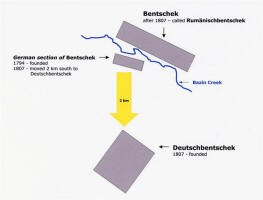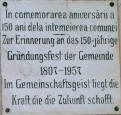|
|
|
|
|
|
Village History:
based on the
Deutschbentschek
family book vol. 1 by Franz Schneider unless noted. |
|
|
|
|
|
|
|
|
|
|
|
|
Background |
|
Deutschbentschek is located in
the 11,000-square-mile area called the
Banat.
When
Deutschbentschek was founded, the Banat was part of the
Habsburg Empire. The area
has changed hands two times
since. More
recently, in 1920, the two-thirds of the
Banat that includes
Deutschbentschek became part of Romania.
|
|
|
|
before 1860 |
|
Part of the Habsburg Empire |
|
|
|
1860-1920 |
|
Part of Hungary |
|
|
|
since 1920 |
|
Part of Romania |
|
|
|
|
|
|
Founding
|
|
|
1792 |
|
In the autumn of 1792, ten
Danube Swabian families from Franzdorf moved
nearly one
hundred kilometers north to live in the already established
village of
Bentschek. Prior to
their arrival,
Bentschek was populated by Romanian people. The Franzdorf families
chose the distant Bentschek because of
its
good soil and its closeness to their friends
and relatives in nearby Bruckenau.
|
|
1793 |
|
The Franzdorf families obtained
permission from Timisoara to build their homes
on the
other
side of the Bazin Creek from the Romanian inhabitants of
Bentschek.
|
|
|
|
1794 |
|
In March of 1794, the ten
families from Franzdorf, along with thirty-or-so
families
from
Zichydorf, officially founded the German section of the
village of
Bentschek.
|

Commemorating 200 years
of German settlers in Bentschek
1794-1994
(click photo to enlarge)
Photo
courtesy of Richard Schicht & Jim Hulka
|
|
|
|
|
|
|
|
|
|
Relocation
|
|

(click map to enlarge)
Map after Schneider 2003 |
|
|
|
|
1807 |
|
Outbreaks of
malaria and other illnesses due to the location of the
village on the damp, low-lying land next to Bazin Creek,
prompted the
Germans to relocate their community
to a hilltop two kilometers south of Bentschek (Dreyer
and Hatter 2006).
From then on, their village was known as
Deutschbentschek, and the Romanian village
of Bentschek
was
called Rumänischbentschek.
Today, the official
names of these two villages refer to the geography of their
locations:
Deutschbentschek, located on a hill, is
called Bencecu de Sus (sus meaning "up" or "top"
in
Romanian);
Rumänischbentshcek, located in a valley, is
called is called Bencecu de Jos
(jos meaning
"down" or
"bottom").
 In
memory of the 150-year In
memory of the 150-year
Foundation Celebration
1807-1957
In community lies the power
that shapes the future.
(click photo to enlarge)
Photo
courtesy of Richard Schicht & Jim Hulka
|
|
|
|
|
|
|
|
Roman Catholic Church & Cemetery
|
|
|
|
|
|
1793 |
|
The people of Bentschek were
associated with the parish in Bruckenau. |
|
|
|
1799 |
|
The people of Bentschek were
associated with the parish in Königshof. |
|
|
|
1807 |
|
The people of Deutschbentschek
were associated with the parish in Jahrmarkt. |
|
|
|
1825 |
|
On August 20, 1825, the people
of Deutschbentschek got their first
priest,
Stefan Kempka. |
|
|
|
1832 |
|
The groundbreaking ceremony
for the Deutschbentschek church was held
on
June 19, 1832. |
|
|
|
1833 |
|
On September 15, 1833, the
church was completed and consecrated. |
|
|
|
1900 |
|
The church was enlarged by the
addition of two side aisles. |
|
|
|
1929 |
|
A lightning bolt struck the
steeple, after which the tower was given a tin roof. |
|
|
|
1942 |
|
The church was renovated and
the shingle roof replaced. |
|
|
|
2007 |
|
On the occasion of the 200th
anniversary of Deutschbentschek, after general repairs,
the
church was reconsecrated. |
|
|
|
|
|
|
|
|
|
|
|
|
|
|
|
1807 |
|
The Deutschbentschek cemetery
was dedicated on May 11, 1807. The first person
buried in the new cemetery was
39-year-old Katharina Kerner
(born Waller) on
June 27, 1807. |
|
|
|
1992 |
|
The last burial was that of
90-year-old Agatha Scheirich (born Saladin) on
December 25,
1992. |
|
|
|
|
|
|
Catastrophic Events
|
|
|
|
|
|
1817 |
|
Plague epidemic |
|
80 people died. |
|
|
1829 |
|
Plague epidemic |
|
62 people died. |
|
|
1832-1833 |
|
Cholera epidemic |
|
70 people died. |
|
|
1836 |
|
Cholera epidemic |
|
60 people died |
|
|
1854 |
|
German measles epidemic |
|
45 children under the age of
ten died. |
|
|
1914-1919 |
|
World War I |
|
317 served; 55 died (Handl,
1985).
(See
names of those who died.) |
|
|
1943-1945 |
|
World War II |
|
211 served; 53 died (Handl,
1985).
(See
names of those who died.) |
|
|
1945-1949 |
|
Soviet deportation
(scroll down to section 2) |
|
258 villagers (women born
1914-1927; men born 1899-1928) taken some 1500 km east to
Soviet
labor camp #1028 (near Krasnoarmiis'k, Ukraine) or #1220
(near Swerdlowsk, Ukraine); 40 died (Handl, 1985).
(See
names of those who died.) |
|
|
|
|
|
|
|
|
|
|
Population |
|
Through births and additional
migrants, the German population of
Deutschbentschek
grew steadily until about 1900 and made up approximately
95% of
the total population
of the village by that time.
The number
of villagers began a
slow decline after 1900,
but the ratio of Germans to
total
inhabitants
remained the same until 1940. After
1940, the number
and
percentage
of
Germans declined drastically.
On October 3, 1995, the last Banater Swabians, Johann and
Theresia
Altenbach (born
Scheirich), left Deutschbentschek
to live with their daughter
in Germany.
|
|
|
|
| |
|
1800 |
|
1830 |
|
1850 |
|
1880 |
|
1900 |
|
1941 |
|
1977 |
|
1992 |
|
|
|
TOTAL |
German |
Romanian |
Hungarian |
Other |
|
|
307 |
NA |
NA |
NA |
NA |
|
|
854 |
NA |
NA |
NA |
NA |
|
|
1290 |
NA |
NA |
NA |
NA |
|
|
1592 |
1522 |
49 |
14 |
7 |
|
|
1703 |
1638 |
37 |
21 |
7 |
|
|
1433 |
1380 |
17 |
36 |
0 |
|
|
1027 |
469 |
517 |
39 |
2 |
|
|
848 |
10 |
808 |
22 |
8 |
|
|
|
|
|
Table after Weresch 1979 and Romanian Wikipedia
Bencecu de Sus
entry |
|
|
|
|
|
|
|
References:
|
|
Dreyer, David,
and Josette S. Hatter (2006). From the Banat to
North Dakota: A History of the German-Hungarian Pioneers in
Western North Dakota. Fargo: Institute for
Regional Studies, North Dakota State
University.
Handl, Adam. Deutschbentschek: ein Dorf im Banat.
Heilbronn: Selbstverlag, 1985.
Schneider,
Franz (2003). Familienbuch der katholischen Pfarrgemeinde
Deutschbentschek im Banat und ihrer Filialen
Rumänischbentschek, Janowa, Herneakowa, Nadasch und
Stantschowa: 1793/1794 - 1852..., Band I. Friedrichsdorf:
Zentralstelle für Personen- und Familiengeschichte.
Weresch, Hans (1979). Deutschbentschek: ein Dorf im
rumänischen Banat Heimatbuch. Freiburg: H. Weresch.
|
|
|
|
|
|